Sauerkraut

Deliciously salty and sour, sauerkraut is a popular topping for hot dogs, burgers, meat, and much more. Though this fermented white cabbage has a German name, the tangy 'sour cabbage', which is also called 'kraut' for short, is popular in many different countries. And really, it is no wonder why! The soft yet slightly crunchy texture and acidic, salty flavour make it well-suited for many different dishes. But do not just take our word for it, give our easy sauerkraut recipe a try and decide for yourself!
Ingredients
|
1 kilo
White cabbages, finely chopped
|
|
|---|---|
|
25 g
Coarse salt (should be 2.5% of the cabbage)
|
Instructions
Recipe tips
It’s often the small details that make the biggest impact in the kitchen, so we’re sharing the tips we rely on when cooking and creating recipes
To successfully ferment shredded cabbage, you need the correct salt-to-cabbage ratio. The perfect ratio for fermentation is at least 2.5% salt by weight. Make sure, to spend at least a couple of minutes massaging the shredded cabbage after sprinkling it with salt to get the process started.
You might have been wondering whether to strain the cabbage after fermentation. The answer to that is a resounding no. Keeping it submerged in its brine prevents oxidisation and discolouration and preserves it, and if it is not submerged, it will surely go bad. Draining it will, as such, not prolong its shelf life but rather make it deteriorate fast.
Also, make sure to use a clean bowl for the cabbage. If it is not clean, the bacteria in it will make it go bad. You can, for example, sterilise it with boiling water.
Questions about sauerkraut
With a quick recipe, making sauerkraut takes only a few days but does not require much work. To learn more about this type of fermented cabbage, read our answers to the most frequently asked questions about it below.
How to make sauerkraut?
Homemade sauerkraut is a great topping for various dishes. To make it, rinse and shred the cabbage. Transfer it to a large bowl and sprinkle it with salt. Massage the cabbage until it begins to soften and release its brine. The cabbage should be left to ferment at room temperature for 2-3 days. But first, make sure to protect it from oxygen and keep it immersed in brine by covering it with parchment paper and a plate that fits the bowl. After fermentation, transfer it to the fridge and enjoy it as a deliciously sour side dish.
What to eat with sauerkraut?
Some of the best suggestions for how to eat sauerkraut is to use it with pork dishes. The pairing of the rich but mild and slightly sweet-tasting meat and the textured, sour cabbage is simply marvellous. Essentially, the fermented cabbage can be used to add some crunch or introduce a bit of tanginess into a range of dishes ranging from stews to salads.
What does sauerkraut taste like?
It should have a slightly sour taste. The flavour profile becomes vinegary as the cabbage ferments, and the salt helps this process of turning the cabbage's natural sugars into brine and adds saltiness as well as hints of umami. The texture should be softer than raw cabbage and still have a slight crunch.
How long does sauerkraut last?
Homemade sauerkraut is good for 1-6 months depending on where you store it. It may be stored either on the countertop for 1 month or in the fridge for up to 6 months. Though it will continue to ferment and become sourer and more acidic, the process will be slowed down considerably in this cold environment. If you are wondering how to store homemade sauerkraut to prolong its shelf life, the most important thing you can do is protect the fermented cabbage from oxygen and store it in an airtight environment.
How long to ferment sauerkraut?
At room temperature, it only takes shredded white cabbage about 2-3 days to ferment. The fermentation process is dependent on the temperature of the surrounding environment (around 21°C is ideal) as well as how well you squeeze the shredded cabbage with salt. Spending at least 5 minutes on this part of the preparation is, as such, well worth your time as it will mean you get to enjoy it faster.
How to tell if sauerkraut is bad?
Though it has a long shelf life, fresh sauerkraut will at some point go bad. The best way to examine fermented cabbage is to smell and look at it. If the smell has become yeasty, mouldy, or funky smelling in any way, toss it and make yourself a new batch. The same goes if it has gained a slimy texture or has a white film covering its surface. Unrefrigerated fermented cabbage will go bad faster than if you store it in the fridge.
What is the difference between kimchi and sauerkraut?
While sauerkraut is made using only white/green cabbage and salt, kimchi, a traditional Korean dish, is usually made with ingredients like Napa cabbage and daikon (Korean radishes) as well as seasonings like green onions, scallions, red chilli peppers, pepper flakes, and fish sauce, and sometimes even more ingredients. As such, kimchi has a spicier and saltier flavour, whereas the flavour profile of regular fermented cabbage leans more on the tangy, briny, and acidic side.
Can you freeze sauerkraut?
It is possible to freeze sauerkraut and still retain its signature flavour and prolong its shelf life even further. In the freezer, it will keep for up to 6 months. To ensure it is flavourful upon being thawed, you should freeze it when it is still quite fresh. Thaw it overnight in the fridge before adding it to dishes in need of a bit of tang.
Nutritional values
Nutritional value, per
245 Kcal
| Fibre | - | 26 gram fibers |
| Protein | 18.3 | 11 gram |
| Fat | 3.6 | 1 gram |
| Carbohydrates | 78.1 | 47 gram |
Recommended information
Serving suggestion
Homemade sauerkraut – deliciously salty and sour
Making homemade sauerkraut requires just two ingredients, cabbage and salt, and a bit of patience as it takes 2-3 days to ferment to perfection. It makes for a delicious topping for dishes that could use a bit of a flavour punch as well as crunchiness.
Fermented cabbage naturally develops a delightfully sour flavour profile with a lot of tanginess and salty undertones. Over time, it will become sourer and sourer which may lead to plenty of fun experimentation as you try to work out at what point you enjoy it the most. The process of making it involves a lot of smelling and tasting and, as such, it presents a wonderful way to build up your cooking experience and confidence in the kitchen.
Getting that characteristic fermented flavour
Humans have been making fermented foodstuffs like fermented cabbage, pickled vegetables, and yoghurt for millennia. Salting vegetables and letting them age in an airless environment is a great conservation method that, in addition to giving them a long shelf life, also gives them the characteristic, tangy taste that you know and love in, for example, sauerkraut.
So, when you make fermented sauerkraut from scratch, the natural sugar that the white cabbage contains is turned into lactic acid during the fermentation process, giving the cabbage its signature acidic, sour flavour.
The perfect side for various dishes
There are many delicious uses for sauerkraut, which presents a great way of adding a bit of tang, salt, and crunch to just about any dish. Though many serve it as a side to warm dishes like roasts or stir-fries it is also great in salads. Since pork and sauerkraut make a classic combination, we will now delve a bit deeper into this delicious pairing.
Sauerkraut and pork, sausages, and hot dogs
The tangy and salty flavours of fermented white cabbage beautifully complement pork as this type of meat is naturally rich and has mild and a slightly sweet flavour profile. As such, we highly recommend pairing pork chops and sauerkraut, serving it with moist pork tenderloin, or combining sausage and sauerkraut to make delicious homemade hot dogs with homemade toppings.
Sauerkraut on hot dogs may just be one of the best ways to use fermented cabbage as it adds a wonderful crunch and brightness to the dish. Rather than using coleslaw, which gains its tangy pickled flavour from vinegar, you can also use it in a pulled pork sandwich where the acidity of the cabbage rounds out the richness of the slow-cooked meat.
Find the best cabbage to use
This recipe can essentially be made with any kind of cabbage. The best cabbage for sauerkraut depends on whether you prefer a flavourful and crunchy variant (white/green cabbage, red cabbage, pak choi) or a milder one that is softer in texture (Savoy cabbage, Napa cabbage). The red cabbage variety, which has a stunning dark pink colour, might be a bit sweeter than a classic one.
No matter which kind of cabbage you decide to use, you should select a dense, heavy one that is firm to the touch. These contain a high quantity of water which means that they will produce a lot of brine during the fermentation process.
Flavour your sauerkraut with herbs and spices
Though a simple sauerkraut recipe requires just two ingredients, there is much to gain from experimenting with adding different flavours. A traditional recipe will often suggest adding fragrant seasonings such as juniper berries, caraway seeds, and mustard seeds.
If you think a spicy version might be just up your alley, try adding red pepper flakes or diced jalapeños to your cabbage for a flavourful chilli-spiced variety. Another way to introduce a bit of heat is to use fresh, finely grated ginger and garlic as well as ground cumin for a warming version that is a bit easier on the tastebuds.
Finally, you cannot go wrong with a citrussy and aromatic combination of classic flavours like garlic, dill, and lemon. These ingredients will brighten the cabbage and give it a wonderful depth.









